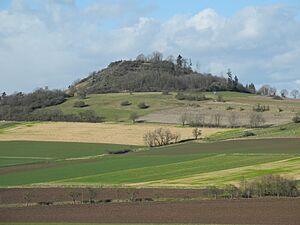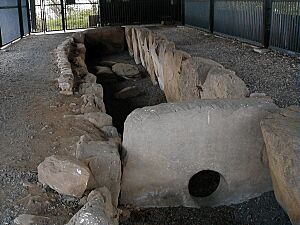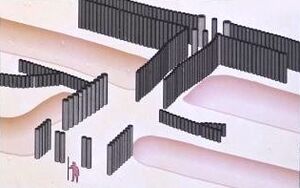Wartberg culture facts for kids
| Geographical range | Germany: Northern and Central Hesse, Westphalia, South Lower Saxony, West Thuringia. |
|---|---|
| Period | Later Neolithic |
| Dates | 3,600–2,800 BC |
| Characteristics | collared bottles, strap-handled cups, hilltop settlements, gallery graves, enclosures |
| Preceded by | Michelsberg culture |
| Followed by | Corded Ware culture, Single Grave culture |
The Wartberg culture was a group of people who lived in Central Europe a very long time ago, from about 3,600 to 2,800 BC. This was during the later part of the Neolithic Age, also known as the New Stone Age. The culture is named after a hill called Wartberg in northern Hesse, Germany.
Contents
What was the Wartberg Culture?
The Wartberg culture is an archaeological culture. This means archaeologists have found similar objects and remains in certain areas. These finds help us understand how these ancient people lived. Sometimes, this group is also called the Wartberg group or the Collared Bottle culture. This last name comes from a special type of bottle they made.
Where did the Wartberg Culture Live?
The Wartberg culture lived mainly in northern Hesse, southern Lower Saxony, and western Thuringia in Germany. It's possible they lived further south, but archaeologists are still working to confirm this.
When did the Wartberg Culture Exist?
The Wartberg culture existed from about 3600 BC to 2800 BC. It seems to have grown out of earlier cultures like the Michelsberg culture and Baalberge culture. The Wartberg people lived at the same time as the Bernburg culture and the Funnelbeaker culture. Later, the Corded Ware culture and Single Grave culture came after them.
Discovering Wartberg Sites
Archaeologists have found many places where the Wartberg people lived or buried their dead. These sites help us learn about their daily lives and beliefs.
Wartberg Settlements: Homes on Hills
The most famous sites are on hills. These include Wartberg itself, Hasenberg, Güntersberg, and Bürgel. All these hills are in a rich farming area called the Fritzlar basin. Another important site is the Calden earthwork enclosure.
Most of the settlements found so far are on hilltops. One exception is a site at Wittelsberg, which is enclosed but not on a hilltop. It seems that most of the known settlements were built a few hundred years after the Wartberg people started making their special pottery. We don't know much about their very early settlements yet.
At these sites, archaeologists found broken bones from animals like cattle, pigs, sheep, goats, and deer. They also found bones from wild animals such as bears and beavers. Sometimes, even human bone fragments were found in these settlements.
When the Wartberg site was first dug up in the late 1800s, people thought it was a cult place, meaning a place for religious ceremonies. However, finding rough, handmade pottery and pieces of mud walls suggests that people actually lived there.
Giant Stone Tombs: Gallery Graves
Wartberg objects have also been found in a type of megalithic tomb called a gallery grave. These are large tombs made of big stones. The link between these tombs and the Wartberg settlements was only discovered in the 1960s and 1970s. Because of this, the tombs are sometimes studied separately as the "Hessian-Westphalian stone cist group."
Famous examples include tombs at Züschen, Lohra, Naumburg-Altendorf, and Hadamar-Niederzeuzheim. The tomb at Niederzeuzheim was even moved and rebuilt in a park.
These tombs usually held the remains of many people. For example, the Altendorf tomb contained at least 250 individuals of all ages. Most bodies were buried whole, but at Lohra, the dead were burned.
Few items were buried with the dead. These "grave goods" included pottery (especially collared bottles), stone tools, and animal bones. Fox jawbones were often found, which might have had a special, perhaps spiritual, meaning. The Züschen tomb is also special because it has rock art carved into its stones.
Some tombs are directly connected to nearby hilltop settlements. For instance, the Züschen tomb is near the Hasenberg settlement, and the Calden tombs are close to the earthwork. Archaeologists believe these gallery graves show influence from Western Europe, possibly from France, where similar tombs exist. The Wartberg tombs seem to have started being built around 3400 BC, which is earlier than most of the known settlements.
Mysterious Standing Stones
In northern Hesse and western Thuringia, there are many standing stones. We don't know exactly when they were put up. However, their location matches where Wartberg objects are found. This suggests there might be a connection between the standing stones and the Wartberg culture.
Large Enclosures: Ancient Forts or Ritual Places?
The Calden earthwork is a very large enclosure built around 3700 BC. It's made of two ditches and a wooden fence (a palisade), covering an area of 14 hectares (about 35 acres). It has five openings, similar to some ancient enclosures found in the United Kingdom.
This earthwork seems to have come from the Michelsberg culture. However, early finds at Calden show a strong link to the early Wartberg culture. For several centuries, people would bury animal bones and broken pots in pits dug into the ditches. The ditches also contain the remains of many human burials. This activity was especially common during the Wartberg period.
While we don't know the original purpose of the earthwork, it seems likely that in its later years, it had a ritual meaning. It might have been used for ceremonies related to a cult of the dead. In contrast, the enclosure around the Wittelsberg settlement seems to have been built simply for protection or defense.
What Did Wartberg People Use?
Archaeologists have found many interesting objects that tell us about the Wartberg people's daily lives.
Wartberg Pottery: Pots and Bottles
|
|
Wartberg pottery was handmade and often quite rough. Common shapes from the mid-4th millennium BC include saucepans with curved rims and deep cuts, cups with loop handles, and special "collared bottles." Pottery with deep cut patterns and clay drums suggest connections with the Funnelbeaker culture.
Later Wartberg pottery included more strap-handled cups, funnel beakers, different kinds of bowls, large pots with holes below the rim, and collared bottles. The collared bottles are especially interesting because they are found so often, especially in tombs. These bottles were made more carefully than other pots. Their unique shape suggests they had a special use, perhaps for storing valuable liquids like plant oil or sulfur, possibly for healing.
Tools from Stone and Bone
The Wartberg people used many tools made from stone. Axes made of slate were very common, and they also used slate blades. They made excellent stone arrowheads with clear tangs (the part that fits into the arrow shaft) and "wings" (barbs).
They also made various tools from bone, mostly sharp points. These bone tools have been found in both tombs and settlements.
How Did Wartberg People Live?
We can learn a lot about the Wartberg people's way of life from the places they lived and the things they left behind.
Daily Life and Food
The locations of their sites and the objects found suggest that the Wartberg people lived in one place (they were sedentary). They got their food from agriculture (farming) and animal husbandry (raising animals). However, hunting wild animals probably also played a big role in their food supply. The Wartberg area also seemed to trade with nearby regions.
Working Together: Social Life
The existence of large earthworks and shared tombs shows that the Wartberg people worked together on big projects. This means they had a good level of social organisation, where people cooperated and had roles within their community.
Where to See Wartberg Finds Today
If you want to see objects from the Wartberg culture, you can visit these museums:
- Hessian State Museum (Hessisches Landesmuseum), Kassel
- Heimatmuseum Fritzlar
See Also
- Züschen (megalithic tomb)
- Lohra (megalithic tomb)
- Altendorf (megalithic tomb)
- Niedertiefenbach (megalithic tomb)






